Categories: Featured Articles » Electrician at home
Number of views: 98027
Comments on the article: 4
What to consider when performing a three-phase connection of a private house
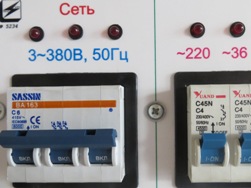 When deciding on the power supply of a newly built building, its owner is faced with numerous tasks that need to be solved by technical and organizational methods.
When deciding on the power supply of a newly built building, its owner is faced with numerous tasks that need to be solved by technical and organizational methods.
In this case, you should initially decide on the necessary number of phases required to power electrical appliances. Usually people are satisfied with a single-phase power supply, and a certain category selects a three-phase, guided by the tasks they face.
Comparison of the advantages and disadvantages of single-phase and three-phase home connection
When choosing a circuit, its influence on the wiring design and operating conditions created by different systems should be taken into account.
Power consumption
There is a hope among individual homeowners that switching to three-phase power can increase the allowed power consumption and use electricity more intensively. However, this issue must be resolved in the sales organization, which, most likely, no longer has extra reserves. Therefore, it is unlikely to significantly increase the consumption of electricity in this way.
The amount of allowed power that will be provided to you will become the basis for creating wiring project. Due to its distribution over two wires in a single-phase circuit, the thickness of the cable core section is always required more than in a three-phase circuit, where the load is evenly distributed across three symmetric chains.
At the same power, lower rated currents will flow in each core of the three-phase circuit. Under them, reduced ratings of circuit breakers will be required. Despite this, their dimensions, as well as other protections and electric meters, will still be larger due to the use of a triple design. A more capacious switchboard will be required. Its dimensions can significantly limit the free space inside small rooms.
Three phase consumers
Asynchronous electric motors of mechanical drives, electric heating boilers, other electrical appliances, designed for operation in a three-phase network, more efficiently, optimally work in it. To them power from a single phase source It is necessary to create voltage converters that will consume additional energy. Moreover, in most cases there is a decrease in the efficiency of such mechanisms and power consumption on the converter.
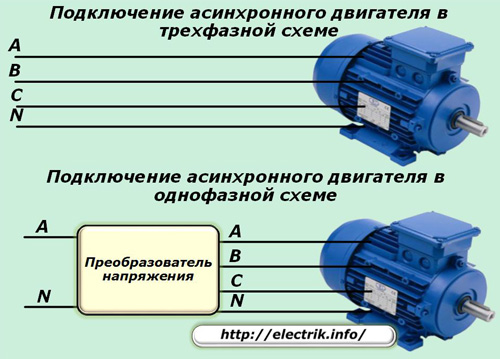
The use of three-phase consumers is based on a uniform distribution of the load in each phase, and the connection of powerful single-phase devices can create a phase-by-phase bias of currents, when some of them begin to flow along the working zero core.
With a large distortion of the currents in the overloaded phase, the voltage decreases: incandescent lamps begin to glow dimly, failures of electronic devices are observed, electric motors work worse. In this situation, the owners of a three-phase wiring can switch part of the load to an unloaded phase, and consumers of a two-wire circuit need to operate voltage stabilizers or backup sources.
Electrical wiring conditions
Owners of a three-phase circuit should take into account the effect of a linear voltage of 380, rather than a phase voltage of 220 volts. Its rating represents a greater danger to humans and the insulation of electrical wiring or appliances.
Dimensions of equipment
Single-phase wiring and all components included in it are more compact, require less installation space.
Based on a comparison of these characteristics, we can conclude that a three-phase connection of a private house can often be inappropriate in modern conditions.It makes sense to apply if there is a need to operate powerful three-phase consumers such as electric boilers or machine tools for continuous operation in certain seasons.
Most household electrical needs may well be provided by single-phase wiring.
How to make a three-phase connection of a private house
When the question of three-phase connection of a private house is acute, you will have to:
1. engage in the preparation of technical documentation;
2. solve technical issues.
What documents need to be prepared
Only the following certificates and passports can ensure the legality of a three-phase connection:
1. technical conditions from the energy supplying organization;
2. The project for the production of power supply to the building;
3. the act of delineation of the balance sheet;
4. measurement reports of the main electrical parameters of the assembled house connection circuit by an electrical laboratory (installation is allowed to be performed after receiving the first three documents) and an inspection certificate of electrical equipment;
5. conclusion of an agreement with a power sales organization, giving the right to receive a work order for inclusion.

Technical specifications
To obtain them, you must first submit an application to the power supply organization, where the requirements for the subscriber and the electrical installation should be reflected, indicating:
-
connection methods;
-
use of protection;
-
locations for electrical appliances and switchboards;
-
restricting access by unauthorized persons;
-
load characteristics.
Power Supply Project
It is developed by the design organization on the basis of current standards and rules for the operation of electrical installations in order to provide the brigade of electricians with detailed information on the installation technology of the electrical circuit.
The project includes:
1. explanatory note with the report;
2. executive circuit diagrams and wiring diagrams;
3. statements;
4. requirements of regulatory documents and regulations.
Balance sheet deed
The boundaries of responsibility between the power supply organization and the consumer are determined, the permitted power, the reliability category of the power receiver, the power supply circuit, and some other information are indicated.
Electrical Measurement Protocols
They are carried out by an electrical measuring laboratory after the completion of installation work. In the case of obtaining positive results of measurements reflected in the protocols, an act of inspection of the equipment is provided with a conclusion giving the right to appeal to an electrical company.
Energy Sales Agreement
After its conclusion, on the basis of documents from the electrical laboratory, you can contact the power supply organization to include the installed electrical installation in the work on a special outfit.
Technical issues of three-phase connection of a private house
The principle of supplying electric energy to a detached residential building is carried out according to the following principle: voltage is supplied from a transformer substation via a power line through four wires, including three phases (L1, L2, L3) and one common PEN neutral conductor. A similar system is carried out by TN-C circuit standards, which is most common so far in our country.
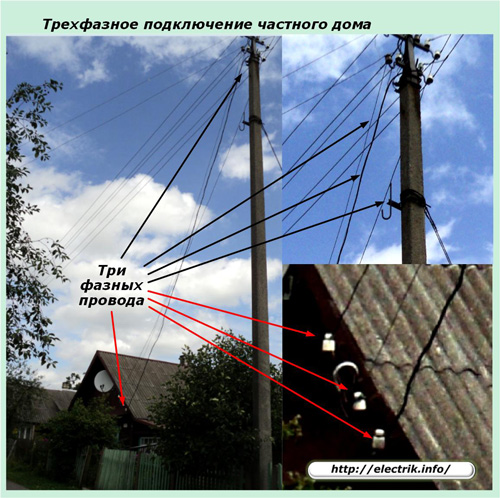
A power line can most often be overhead or less often cable. On both structures, malfunctions can occur that are quickly eliminated in overhead power lines.
Features of PEN conductor separation
The old power lines of energy are gradually starting to modernize, transfer to the new TN-C-S standard, and those under construction will immediately create TN-S standards. In it, the fourth PEN conductor from the supply substation is supplied not by one, but by two branched cores: PE and N. As a result, these circuits already use five cores for conductors.
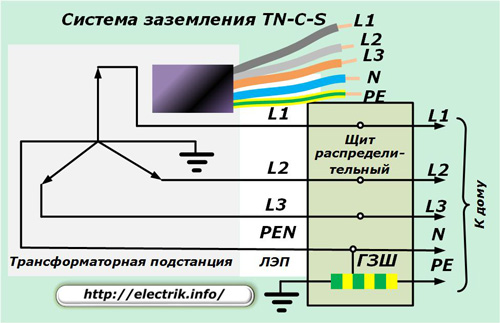
Three-phase connection of a private house is based on the fact that all these cores are connected to the input device of the building, and from it the electricity is supplied to the electric meter and then to the switchboard for internal wiring to the premises and consumers of the building.
Almost all household appliances operate on a phase voltage of 220 volts, which is present between the working zero N and one of the potential conductors L1, L2 or L3. And between the linear wires a voltage of 380 volts is formed.
Inside the input device using the TN-C-S standard, the working zero N and protective PE are extracted from the PEN conductor, which is connected here to the GZSh - the main grounding bus. It is connected to the building earth ground loop.
All connections of conductors on the GZSH are carried out by bolting with washers and nuts, firmly tightening the threaded connection. This achieves the minimum value of the transient electrical resistance at the junction of the contacts. Each cable is connected to a separate mounting hole for convenient opening of the circuit in order to conduct various measurements.
Copper is the main material for gypsum board, and in some cases it is allowed to use steel alloys. The use of aluminum for the main busbar is prohibited. On the wires connected to it, it is impossible to mount lugs made of aluminum alloys.
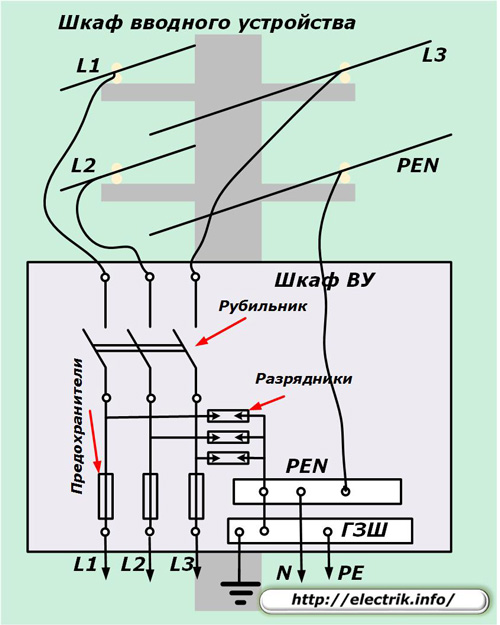
From the input device, the working and protective zeros go in isolated chains, which are forbidden to be combined at any other point in the wiring diagram.
According to the old rules that were in effect in the TN-C grounding circuit, the PEN conductor was not split, and the phase voltage was taken directly between it and one of the linear potentials.
The final gap of the line between its support before entering the house is laid by air or underground. It is called a branch. It is on the balance sheet of the power supply organization, and not the owner of the residential building. Therefore, all work on connecting the house on this site should be carried out with the knowledge and by decision of the power line owner. Accordingly, they will require legislative approval and payment.
At the underground cable line, the branch is mounted in a metal cabinet, which is placed close to the route, and for an overhead power line, directly on the support. In both cases, it is important to ensure the safety of their operation, to block the access of unauthorized people and to provide reliable protection against damage by vandals.
PEN conductor splitting
It can be performed:
1. on the nearest support;
2. or on the introductory board located on the wall or inside the house.
In the first case, the responsibility for safe operation rests with the power supply organization, and in the second case, the owner of the building. Access for tenants to work on the end of the PEN conductor located on the pole is prohibited by the rules.
It should be borne in mind that the wires on the overhead line can break for various reasons and malfunctions can occur on them. During an accident at a power line with an open PEN conductor, its current will flow through a wire connected to an additional ground loop. Its material and cross-section must reliably withstand such increased power. Therefore, they are chosen no thinner than the main core of the power line.
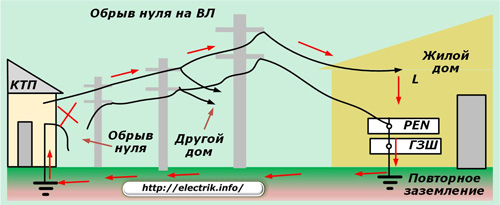
When splitting is performed directly on the support, a line called re-grounding is laid to it and the contour. It is convenient to make it from a metal strip buried in the ground at 0.3 ÷ 1 m.
Since a lightning path into the ground is created through it into a thunderstorm, it must be diverted from paths and places where people can be accommodated. It is rational to lay it under the fence of the building and in similar inaccessible places, and all connections should be made by welding.
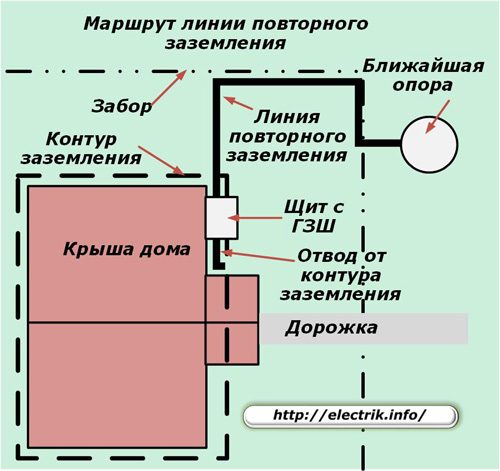
When the splitting is carried out in the building’s water shield, emergency currents that can withstand only conductors with a cross-section of the phase conductors of the power transmission line will flow through the branch line with connected wires.
Electricity Inlet Switchgear
It differs from a simple input device in that its design includes elements that distribute electricity among consumer groups within the building. It is mounted on the input of the electric cable in the extension or in some separate room.
The switchgear is installed inside a metal cabinet where all three phases, PEN conductor and the bus of the re-grounding circuit in the building wiring diagram according to the TN-C-S system, are brought in.
For TN-S, five cores are brought into the input distribution cabinet - three phases and two zeros: working and protective, as shown in the picture below.
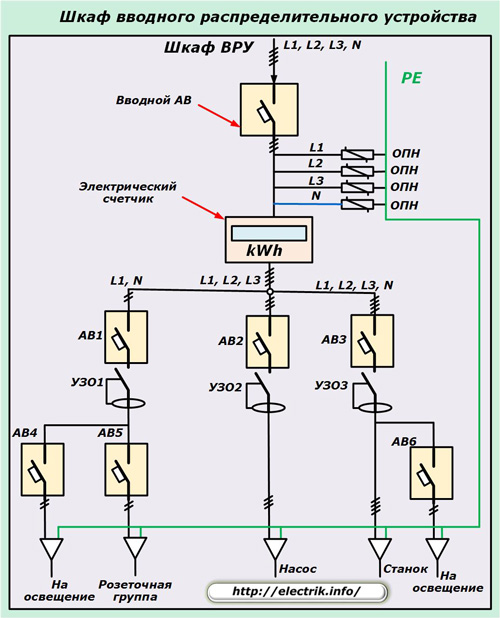
Inside the cabinet of the input switchgear, the phase conductors are connected to the terminals of the input circuit breaker or power fuses, and the PEN conductor is connected to its bus. Through it, it is split into PE and N with the formation of the main grounding bus and its connection to the secondary ground loop.
Voltage surge limiters operate on a pulsed basis, protect the phase circuit and working zero circuit from the effects of possible penetration of extraneous external discharges, divert them through a PE conductor and the main protective bus with an earth circuit to the earth potential.
In the event of the occurrence of high-voltage pulse discharges of high power in the supply line and their passage through a series circuit from a circuit breaker and an SPD, failure of the power contacts of the machine due to burning and even welding them is quite possible.
Therefore, the protection of this chain by powerful fuses, performed by a simple fuse of the fuse-link, remains relevant and is widely used in practice.
Three-phase electric meter takes into account the consumed power. After it, the connected loads are distributed among consumption groups through correctly selected circuit breakers and residual current circuit breakers. Also, an additional RCD can be installed at the input, performing fire-fighting functions for the entire electrical wiring of the building.
After each group of RCDs, additional dividing of consumers according to the degree of protection by individual automatic machines or without them, as shown by different sections in the diagram, can be performed.
At the output terminals of the shield and protection, cables are connected to the groups of end consumers.
Branch design features
Most often, a three-phase connection of a private house on a power line is carried out by an air line, which can cause a short circuit or break. To prevent them, you should pay attention to:
-
general mechanical strength of the created structure;
-
insulation quality of the outer layer;
-
material of current-carrying veins.
Modern self-supporting aluminum cables have a low weight, good conductive properties. They are well suited for mounting an air branch. With three-phase power supply to consumers, the cross-section of the SIP core of 16 mm2 will be enough for a long time to receive 42 kW, and 25 mm square - 53 kW.
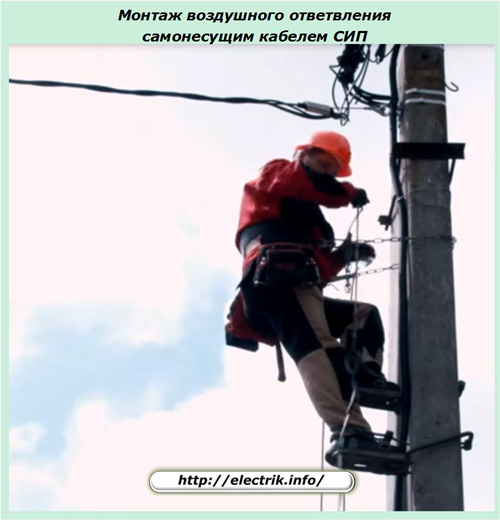
When the branch is performed by an underground cable, then pay attention to:
-
the configuration of the route being laid, its inaccessibility for damage by unauthorized people and mechanisms when working in the ground;
-
protection of ends coming out of the earth with metal pipes to a height not less than the average human height. The best option is the complete placement of the cable in the pipe up to the input into the control unit and the control cabinet.
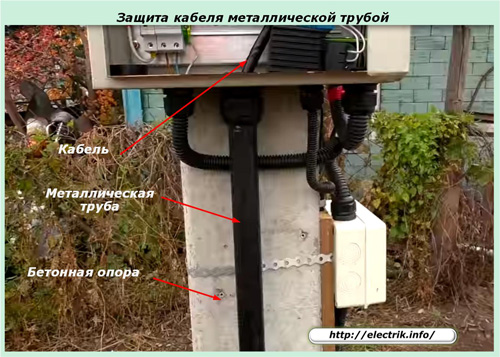
For underground laying use only a single piece of cable with a strong armor tape or carry out its protection with pipes or metal boxes. At the same time, copper conductors are preferable to aluminum.
The technical aspects of the three-phase connection of a private house in most cases require more costs and effort than with a single-phase circuit.
See also at e.imadeself.com
:
